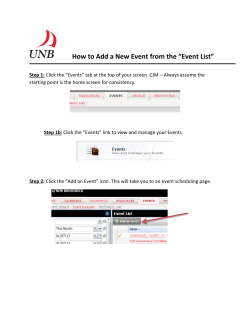
What is FitNesse and should I use it? Gojko Adzic
What is FitNesse and should I use it? Gojko Adzic gojko@gojko.com http://gojko.net @gojkoadzic Plan for today: Where FitNesse works best What is it anyway? How people misuse it How not to shoot yourself in the foot Test? Inspection to find defects is waste, inspection to prevent defects is essential Mary and Tom Poppendieck Lean Software Development One of the most effective ways of testing requirements is with test cases very much like those for testing the completed system Donald Gause and Gerald Weinberg Exploring Requirements - 1989! As formality increases, tests and requirements become indistinguishable. Robert C. Martin and Grigori Melnik Tests and Requirements, Requirements and Tests: a Mobius Strip IEEE Software January/February Issue 2008 Unit test = target for development: A test can be our light at the end of the tunnel But what if it's actually a train? But they aren't really readable Here's what I thought... When the order is in a “pending” state, we first check the account, and if approved move it to “confirmed” state When the order is manually confirmed, it moves from the “pending” to “confirmed” state even if the account does not have enough funds When the order is in a “pending” state for two days, we send an alert Here is what they saw: ghorgh [the] [order] 'oH Daq [a] [“pending”] [state] maH wa'DIch [check] [the] [account] 'ej chugh [approved] vIH 'oH Daq [“confirmed”] [state] ghorgh [the] [order] 'oH [manually] [confirmed] 'oH vIHtaH vo' [the] [“pending”] Daq [“confirmed”] [state] 'ach chugh [the] [account] ta'taH ghobe' ghaj yap [funds] ghorgh [the] [order] 'oH Daq [a] [“pending”] [state] vaD cha' jajmey maH ngeH [an] [alert] http://www.mrklingon.org / FitNesse allows us to specify automated but human readable business tests! How FIT works FitNesse Ward Cunningham wrote FIT in 2002 – no IDE/ management tool Robert Martin and Micah Martin wrote FitNesse in 2005: − Wiki − Test suites, includes, symbolic links, markup variables... − Integrated reporting and execution − Integrates with almost anything easily So what is it anyway? An opensource tool to manage executable specifications (acceptance criteria – tests) for development A collaboration tool for business people, developers and testers Works as a Web server, use it through a browser Supports Java, .NET, C++, Smalltalk, Python... Where it really works Agile testing quadrants idea by Brian Marick, picture by Janet Gregory It's excellent for: Defining and organising tests that are used as acceptance criteria for the project/iteration/piece of code Managing a “live” documentation of the project business functionality Collaborating between business people, testers and developers It's usable (but not really good) for: Managing lots of different types of tests (eg ui tests, database tests) Integration testing Testers or developers working in isolation − Pure regression testing It's definitely not: Usable for Unit testing Built for general purpose test management Suitable for performance testing Suitable for GUI testing A REPLACEMENT FOR QTP, LOAD RUNNER, WIN RUNNER OR ANYTHING LIKE THAT! How to use it properly: focus on what, not on how − Distil the specification from scripts use the business language use realistic examples make pages self-explanatory SMART • Specific, Measurable, Achievable, Relevant, Time-bound How - script rate change date is 23/5 due date rate 22/4 5.40% 22/5 5.40% 22/6 4.90% amount 340.2 340.2 308.7 rate change date is 20/5 due date rate 22/4 5.40% 22/5 5.40% 22/6 4.90% amount 340.2 308.7 308.7 What - specification due date 22/5 22/5 rate changed change reflected in period 23/5 no 20/5 yes Often easier to spot gaps: due date 22/5 22/5 22/5 rate changed change reflected in period 23/5 no 20/5 yes 22/5 ???? Another example of “how” Mike logs on Mike browses to the books page Mike adds “Perfect Software” to the cart Mike adds “Agile testing” to the cart Mike goes to check-out Mike gets offered free delivery what are we specifying here? As a rule of thumb: FitNesse pages should be relatively short − Stuff should not repeat across pages − Specification must be easy to understand Don't copy and paste, make specification clear and focused Fixtures should be very thin − Just an adapter to your code − Shouldn't contain logic − Use them to script test workflow Best practices to keep tests good: Keep in the same SCM as the code Keep them organised and easy to find Evolve the language consistently Clean up periodically Common symptoms of problems Technical tests − Reflect the way the code was written − Use technical jargon/class names − Favour reuse over clarity Common symptoms of problems Long/complex tests − Specify too much (how not what) − Check for every possible case − These tests are important, but not as a spec copy/paste from other tests things that aren't really needed Distil the specification Common symptoms of problems Lots of tests with minor differences in some values − copy/paste? − How, not what? Distil “what”, create a single test out of the whole group Interdependent tests Copy/paste? − − Common dependencies? Parts used to set up/clean up after related tests Extract common dependencies into test suites Push technical activities into fixtures Common symptoms of problems Tests that fail intermittently − Unreliable − Asynchronous processes? − External dependencies? − Problems in the implementation? − Data dependency? − Random values? Work out what's wrong and fix it Bridging the Communication Gap learn how to improve communication between business people and software implementation teams find out how to build a shared and consistent understanding of the domain in your team learn how to apply agile acceptance testing to produce software genuinely fit for purpose discover how agile acceptance testing affects your work whether you are a programmer, business analyst or a tester learn how to build in quality into software projects from the start, rather than control it later http://www.acceptancetesting.info upcoming events.... testing... 27/5: Acceptance testing tools roundup 23/6: Testable software is good software .NET 19/5: F# and Lucene.NET 16/6: Rake.NET and Iron Ruby
© Copyright 2025





















